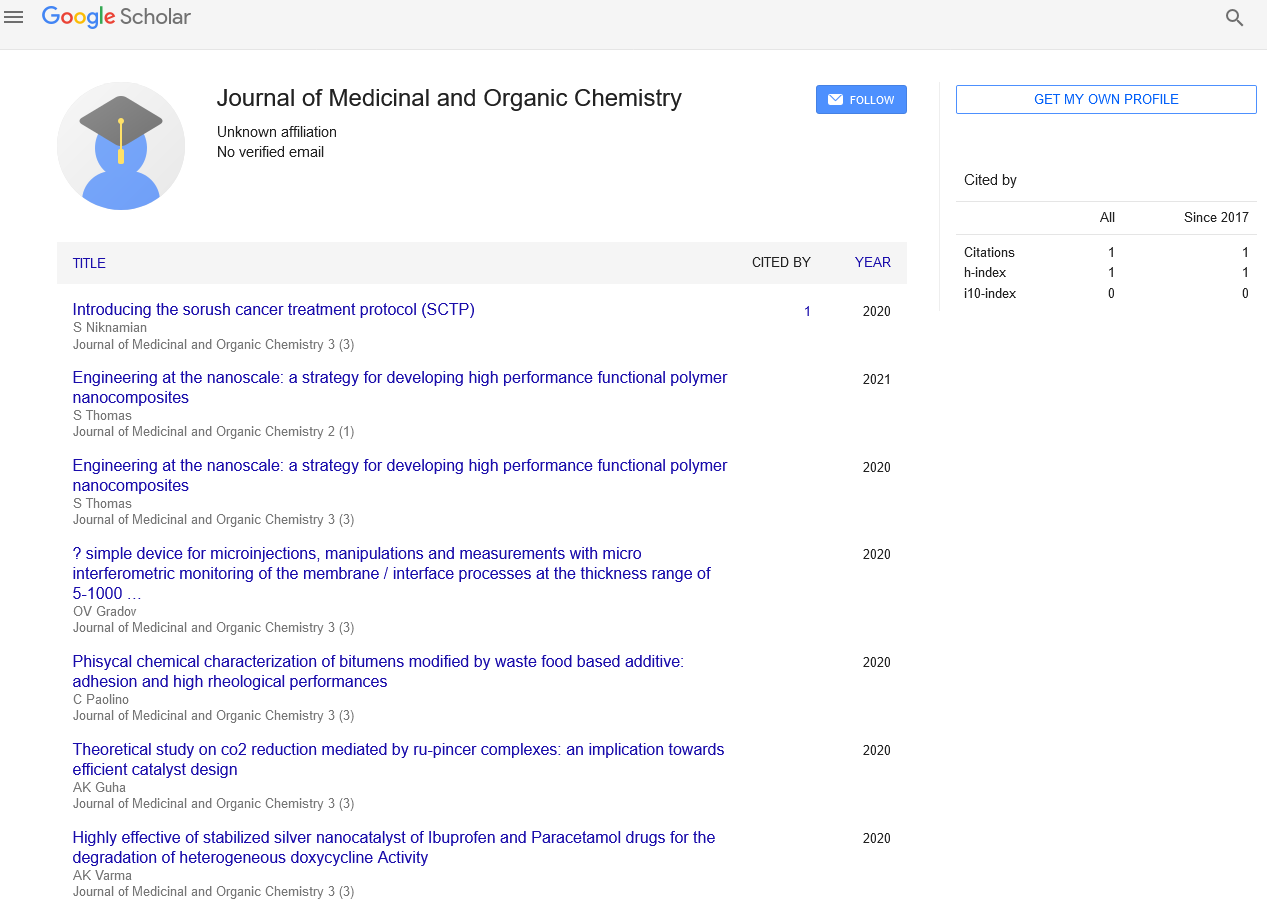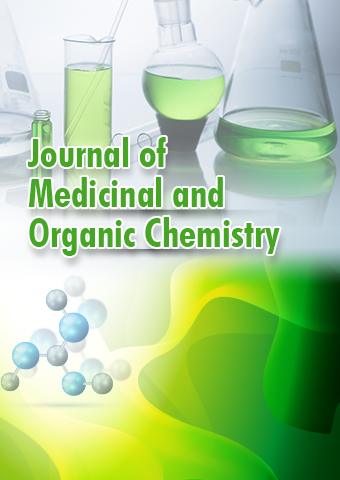Editorial - Journal of Medicinal and Organic Chemistry (2023) Volume 6, Issue 1
Immune Function and Drug Discovery: The Genetics of Immunity
Dr. Ben Stokes*
Department of psychosocial research, University of Science and Technology, United States
Department of psychosocial research, University of Science and Technology, United States
E-mail: b.stokes@gmail.com
Received: 02-Feb-2023, Manuscript No. jmoc-23-89041; Editor assigned: 06-Feb-2022, PreQC No. jmoc-23- 89041; Reviewed: 13- Feb-2023, QC No. jmoc-23-89041; Revised: 23-Feb- 2023, Manuscript No. jmoc-23-89041 (R); Published: 28-Feb-2023; DOI: 10.37532/jmoc.2023.6(1).10-12
Abstract
An organism's defense mechanism against pathogenic stress includes the immune system as an essential component. Increased susceptibility to infections, increased onset and progression of autoimmune diseases, and the onset of neoplastic diseases are all symptoms of age-associated immune dysfunction, which is also known as "immune senescence." In terms of the phenotypic and functional defects in the immune system of various organisms, including humans, extensive research has produced consensus over the years. It has been demonstrated that immune decline is caused by age-related changes like thymic involution, skewing of the T cell repertoire, decreased capacity to activate naive T cells, and diminished capacity to generate robust memory responses. In addition, identifying the signaling pathways that interact with immune senescence and influence it has been made possible by comprehending the molecular mechanisms that are responsible for the development of proteotoxic stress, the DNA damage response, the modulation of the ubiquitin proteasome pathway, and the regulation of transcription factor NFB activation in immune decline.
Keywords
Immune dysfunction • Phenotypic • Autoimmune diseases • DNA damage response • Immune senescence
Introduction
An effective cross-talk between the physiological responses that promote effective homeostasis and the harmful processes that affect an organism over its lifetime is what determines longevity [1]. The gradual functional decline that occurs over time in a variety of organ systems is what we mean when we talk about aging. Although the accumulation of damage to macromolecules is regarded as a marker of the conserved aging phenotype across species, the type of damage that is most important in starting the aging process, the driving force for maintaining and sustaining these damages, and the fundamental cause of the damage that causes physiological aging are the subject of intense research [2]. Age-related degenerative processes that lead to loss of function have an effect on immune responses, as shown. In point of fact, the decline in the function of the immune system is one of the well-documented physiological declines that have a significant impact on individuals’ health spans in response to stress or damage. Because it is a sensor and defender of pathogenic signals, the immune system plays a crucial role in spotting changes that occur as we get older. A failure to defend against impinging noxious and infectious agents frequently defines immune dysfunction that accompanies aging, compares the immune function observed in young humans to elderly humans, and outlines the challenges posed by declining immunity in the elderly. Stressors frequently define the boundaries of a system. In fact, studies on the aging of the immune system have been the focus of a lot of labs because of its central role in defense and the increased susceptibility to infectious diseases that comes with age. Understanding and combating immune senescence will likely contribute to extending the health span of the elderly population, as recent projections estimate that the proportion of the world’s population with elderly people will double from 7% of the total population now to 14% in 2040 [3].
Immune system and drug discovery
Studies of immune regulation in novel contexts are reported in several of the highlighted articles. Investigated the modulation of the Toll pathway, which is best known in Drosophila for its function in activating the synthesis of antimicrobial peptides in response to bacterial infection and in vertebrates for inducing inflammatory responses to elicitors of microbial and viral origin [4]. Focused on the activity of the Toll pathway in Drosophila larvae, this study came to the conclusion that misactivation causes inflammation-like phenotypes like an increase in the proliferation of lamellocytes (immune cells), the appearance of melanotic masses, and the induction of antimicrobial peptides. They discovered that sumoylation, which is controlled by the -arrestin gene Kurtz, has a negative effect on Toll activity in Drosophila larvae. Ectopic immune activity and inappropriate responses resembling inflammation are triggered when either the SUMO protease Ulp1 or Kurtz are missing. However, sumoylation probably works with other parts of the cellular machinery to balance the many activities of the highly pleiotropic Toll pathway by varying the relative magnitudes of the various immune reactions in the mutants. Additionally, due to the global disruption of SUMO activity caused by the Kurtz and Ulp1 mutations, dysregulation of other pathways that help regulate inflammation and immunity is probably the cause [5].
The innate immune system’s cells and cellular factors are the body’s sentinels, protecting it from microbes as the front line of defense. Because we live in a microbial world and are constantly exposed to microorganisms, an individual’s health is largely determined by how well their antimicrobial defenses work. When someone suffers severe burn injuries, failing to respond appropriately frequently results in death [6]. Microorganism invasions are initially repelled by all individuals’ inherent defense mechanisms. Within minutes of encountering invading organisms, this response begins to manifest. As the body’s first line of defense, the innate immune system’s cells and cellular factors provide the foundation for an effective response to pathogens [7]. As aging is frequently associated with a decrease in the function of epithelial barriers like those in the skin, lungs, and gastrointestinal tract, the innate immune cells are put under a lot more pressure to protect against the appearance of a full-blown infection and are constantly on alert. An indirect correlation appears to exist between altered epithelial surfaces and the protection provided by layers of these epithelial cells as mechanical barriers to infection, despite the fact that significant changes in the generation of antimicrobial peptides have not been well documented [8]. There has been some disagreement regarding reports of definitive changes in other innate immune cells and/or factors; some laboratories have reported little or no change, while others have reported a significant decline in functional status with age [9]. Defects in the functional response, but not in the number of neutrophils, have long been demonstrated in aging humans in light of the increased number of bacterial infections and chronic inflammatory conditions that frequently accompany aging.
In a similar vein, it has been reported that certain chemokines and cytokines, which are signal molecules produced by innate immune cells, significantly change with age. These chemokines include proinflammatory cytokines like interleukin (IL)-6, IL-1, tumor necrosis factor (TNF), and transforming growth factor (TGF), which contribute to the inflamm-aging phenotype, which is frequently observed in the elderly. Degenerative geriatric diseases, which frequently accompany advanced age, have been linked to an increase in proinflammatory cytokines as their underlying cause [10].
Conclusion
The immune system’s senescence is mediated by a number of important activators and signaling pathways that are now well understood. However, newer signaling pathways and modules, such as those for miRNA, transcriptional regulation, chromatin remodeling, autophagy, the Ubiquitin- Proteasome system, etc., remain to appear. The aging-milieu direct impact on immune cells, resulting in their loss of function, is also receiving more attention lately. However, it is still unclear whether the observed decline in immune function is the result or cause of cross-talk between the aging organism’s various systems. For instance, is the proinflammatory phenotype that comes with aging a result of misinterpreted cues or a result of constant noxious stimuli?
In general, there are still some significant concerns that need to be resolved: What are the molecular mechanisms and signatures that indicate these changes, as well as the natural stressors that accelerate immune defects seen in aging? What is the connection between the aging of immune cells and immune-niche cells? How do animal models relate to the aging of the human immune system? Can immune deficit-reversing interventions also have an effect on the niche alongside cells?
Acknowledgement
None
Conflict of Interest
None
References
- Kobayashi H. Airway biofilms: implications for pathogenesis and therapy of respiratory tract infections. Respiratory medicine 4: 241-253 (2005).
- Le Bon A, Tough DF. Links between innate and adaptive immunity via type I interferon. Curr Opin Immunol. 14: 432-436 (2002).
- Rojo E, Martín R, Carter C et al. VPEgamma exhibits a caspase-like activity that contributes to defense against pathogens. Current Biology. 14: 1897-1906 (2004).
- Cerenius L, Kawabata S, Lee BL et al. Proteolytic cascades and their involvement in invertebrate immunity. Trends Biochem Sci. 35: 575-583 (2010).
- Oliveira PH, Touchon M, Rocha EP et al. The interplay of restriction-modification systems with mobile genetic elements and their prokaryotic hosts. Nucleic Acids Res. 42: 10618-10631 (2014).
- García-Sastre A, Egorov A, Matassov D et al. Influenza a virus lacking the NS1 gene replicates in interferon-deficient systems. Virology. 252: 324-330 (1998).
- Heaton SM, Borg NA, Dixit VM et al. Ubiquitin in the activation and attenuation of innate antiviral immunity. J Exp Med. 213: 1-13 (2016).
- Baum A, García-Sastre A. Induction of type I interferon by RNA viruses: cellular receptors and their substrates. Amino Acids. 38: 1283-1299 (2010).
- Akira S, Uematsu S, Takeuchi O et al. Pathogen recognition and innate immunity. Cell. 124: 783-801 (2006).
- Kobayashi H Airway biofilms: implications for pathogenesis and therapy of respiratory tract infections. Respiratory medicine. 4: 241-253 (2005).
Indexed at, Google Scholar, Crossref
Indexed at, Google Scholar, Crossref
Indexed at, Google Scholar, Crossref
Indexed at, Google Scholar, Crossref
Indexed at, Google Scholar, Crossref
Indexed at, Google Scholar, Crossref
Indexed at, Google Scholar, Crossref
Indexed at, Google Scholar, Crossref
Indexed at, Google Scholar, Crossref

